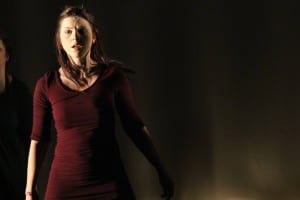The show is really starting to take shape! Each rehearsal I am creating new ideas for the lighting design to reflect each scene and we are now experimenting with projecting onto our bodies in the studios. My job as LD can be somewhat difficult at times as there is often no script to use as a basis for my lighting plans as movement often dominates the play. I did not want the lighting to overshadow the performers’ movement as we produced a highly physical performance. However, certain scenes required more complex lighting states than others. For example, we made a scene with ribbons in which the performers were moving rapidly across the stage to symbolise the fragmented memories that exist in The Man’s brain. As LD, I chose to use strobe lighting to provide both a visually interesting effect and to symbolise the strain that encephalitis has on the brain. However, one thing that I wanted to stray away from as LD was using complex lighting states ‘for the sake of it’ as ‘mood can be subtle or crashingly [sic] obvious’ (Fraser, 2002, 82). Other scenes required more subtle but effective lighting changes. By simply altering the intensity of a single light, the atmosphere is instantly changed. The creation of shadow speaks volumes in itself, particularly during the scene where The Wife is seen to be leaving her husband. I wanted everything to have a meaning behind it; to make sense visually and to the narrative of the piece.

When creating a scene to show the confusion of an encephalitis sufferer, I suggested that we use a Time Lapse projection to create a sense of distortion and confusion. Projecting a fast-moving image of a motorway onto the bodies of the performers created a perfect atmosphere of loss and confusion in the studio – I can’t wait to see what it will look like on the stage! As LD, I am experimenting with the use of colour, using red and blue gels to distinguish the different emotions of scenes. Kirsty and I perform a duet in the piece in which we physicalize the strain that the illness has on the couple’s relationship. I chose to have a blue wash with a 2 minute 13 second fade down to a very dim light on level 10%. Whilst this was technically a fairly simplistic lighting decision, I found it was very effective in delivering the aim of the scene. Coupled with movement, the lighting reflects the dimming of their relationship due to an illness that essentially took over their lives and The Man’s memories.
Ultimately, ‘the soul of lighting design rests not in technical design, rest not in technical considerations but in creating a form in light which is in harmony with the conceptions governing the entire production’ (Palmer, 1967, 142). I therefore ensured that any lighting decisions were reflective of the piece as a whole.
Works Cited:
Fraser, N. (2002) Stage Lighting Explained. Wiltshire: The Crowood Press Limited.
Palmer, R. (1967) Style in Lighting Design. Educational Theatre Journal. 19(2), 142-148.